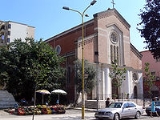
Roman Catholicism in Albania
Encyclopedia
- The information in this article is from the 1911 Encyclopædia Britannica and applies to Albania as it stood at the time of writing. For current information, see :de:Katholische Kirche in Albanien
The Roman Catholic Church in Albania
Albania
Albania , officially known as the Republic of Albania , is a country in Southeastern Europe, in the Balkans region. It is bordered by Montenegro to the northwest, Kosovo to the northeast, the Republic of Macedonia to the east and Greece to the south and southeast. It has a coast on the Adriatic Sea...
is part of the worldwide Catholic Church, under the spiritual leadership of the Pope
Pope
The Pope is the Bishop of Rome, a position that makes him the leader of the worldwide Catholic Church . In the Catholic Church, the Pope is regarded as the successor of Saint Peter, the Apostle...
and curia
Curia
A curia in early Roman times was a subdivision of the people, i.e. more or less a tribe, and with a metonymy it came to mean also the meeting place where the tribe discussed its affairs...
in Rome
Rome
Rome is the capital of Italy and the country's largest and most populated city and comune, with over 2.7 million residents in . The city is located in the central-western portion of the Italian Peninsula, on the Tiber River within the Lazio region of Italy.Rome's history spans two and a half...
.
Around 16.8%-17% of the population of Albania is Catholic — the second biggest religious denomination after Islam
Islam in Albania
During the Ottoman rule, according to Ottoman data, the majority of Albanians were of Muslim affiliation . However, decades of state atheism which ended in 1991 brought a decline in religious practice in all traditions....
. More than 100,000 Albanian Catholics are located in south Montenegro under an Albanian Municipality. The region is considered part of the Malsia Highlander region of the seven Albanian Catholic tribes. The region was split after WWII.
There are five dioceses in the country, including two archdioceses plus an Apostolic Administration covering southern Albania.
For four centuries, the Albanian Catholics have defended their faith with the aid of:
- The FranciscanFranciscanMost Franciscans are members of Roman Catholic religious orders founded by Saint Francis of Assisi. Besides Roman Catholic communities, there are also Old Catholic, Anglican, Lutheran, ecumenical and Non-denominational Franciscan communities....
missionaries, especially since the middle of the 17th century, when persecutions by the MuslimMuslimA Muslim, also spelled Moslem, is an adherent of Islam, a monotheistic, Abrahamic religion based on the Quran, which Muslims consider the verbatim word of God as revealed to prophet Muhammad. "Muslim" is the Arabic term for "submitter" .Muslims believe that God is one and incomparable...
lords set in motion the apostasy of many Albanian villages, particularly among the Greeks.
- the College of Propaganda at Rome, especially prominent in religious and moral support of Albanian Catholics. During the seventeenth and 18th centuries, particularly, it educated young clerics for service on the Albanian missions, contributing then as now to their support and to that of the churches.
- the Austrian Government, which gave about five thousand dollars yearly to the Albanian missions, in its role of Protector of the Christian community under Turkish rule. Apropos of the Austrian interest in Albania, it may be stated that it is the Austrian ambassador who obtains from the Sultan the Berat, or civil document of institution, for the Catholic bishops of Albania.
The Church legislation of the Albanians was reformed by Pope Clement XI
Pope Clement XI
Pope Clement XI , born Giovanni Francesco Albani, was Pope from 1700 until his death in 1721.-Early life:...
, effecting a general ecclesiastical visitation (1763) by the Archbishop of Antivari, at the close of which a national synod was held. Its decrees were printed by Propaganda (1705), and renewed in 1803. In 1872, Pius IX caused a second national synod to be held at Scutari
Shkodër
Shkodër , is a city located on Lake of Shkoder in northwestern Albania in the District of Shkodër, of which it is the capital. It is one of the oldest and most historic towns in Albania, as well as an important cultural and economic centre. Shkodër's estimated population is 90,000; if the...
, for the renovation of the popular and ecclesiastical life.
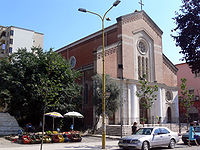
Organisation
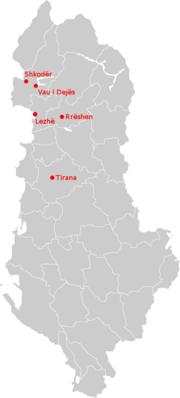
Ecclesiastical Province
An ecclesiastical province is a large jurisdiction of religious government, so named by analogy with a secular province, existing in certain hierarchical Christian churches, especially in the Catholic Church and Orthodox Churches and in the Anglican Communion...
s each headed by Archbishops - Shkodër-Pult in the north and Tiranë-Durrës
Roman Catholic Archdiocese of Tiranë-Durrës
The Roman Catholic Archdiocese of Tiranë-Durrës is an archdiocese located in the cities of Tiranë and Durrës in Albania.-History:* 1300: Established as Metropolitan Archdiocese of Durrës* 1400?: Demoted as Archdiocese of Durrës...
in the centre and south. Shkodrë-Pult has two suffragan Diocese for Lezhë
Lezhë
Lezhë is a city in northwest Albania, in the district and county with the same name. It is located at and has a population of about 27,500...
and Sapë. Tiranë-Durrës has one suffragan Diocese for Rrëshen
Rrëshen
Rrëshen is a small Albanian city and the administrative seat of the Mirditë District, in northern Albania. In 2001, it had a population of 9,240 people.-The City:...
as well as metropolitan authority over the Byzantine Rite
Byzantine Rite
The Byzantine Rite, sometimes called the Rite of Constantinople or Constantinopolitan Rite is the liturgical rite used currently by all the Eastern Orthodox Churches, by the Greek Catholic Churches , and by the Protestant Ukrainian Lutheran Church...
Apostolic Administration of Southern Albania
Apostolic Administration of Southern Albania
The Apostolic Administration of Southern Albania is a diocese located in the Ecclesiastical province of Tiranë–Durrës in Albania. It is a Byzantine Rite Apostolic Administration.-Leadership:* Apostolic Administrators of Southern Albania...
, also known as the Albanian Greek-Catholic Church.
{| class= "wikitable" border= "0"
! Name !! Area !! Catholic Population !! %
|-
| Archdiocese of Shkodrë-Pult
Roman Catholic Archdiocese of Shkodrë-Pult
The Roman Catholic Archdiocese of Shkodër-Pult is an archdiocese of the Latin Rite of the Roman Catholic Church in Albania. The archdiocese has two suffragans, the Diocese of Lezhë, and the Diocese of Sapë.-History:Historically it was known as Scutari...
|| Shkodër
Shkodër
Shkodër , is a city located on Lake of Shkoder in northwestern Albania in the District of Shkodër, of which it is the capital. It is one of the oldest and most historic towns in Albania, as well as an important cultural and economic centre. Shkodër's estimated population is 90,000; if the...
|| 133,000 || 65%
|-
| Diocese of Lezhë
Roman Catholic Diocese of Lezhë
The Roman Catholic Diocese of Lezhë is a diocese located in the city of Lezhë in the Ecclesiastical province of Shkodër–Pult in Albania.-Leadership:* Bishops of Lezhë ** Bishop Ottavio Vitale, R.C.J....
|| Lezhë
Lezhë
Lezhë is a city in northwest Albania, in the district and county with the same name. It is located at and has a population of about 27,500...
|| 85,000 || 71%
|-
| Diocese of Sapë || Zadrima, Vau-Dejes || 90,000 || 45%
|-
| Archdiocese of Tiranë-Durrës
Roman Catholic Archdiocese of Tiranë-Durrës
The Roman Catholic Archdiocese of Tiranë-Durrës is an archdiocese located in the cities of Tiranë and Durrës in Albania.-History:* 1300: Established as Metropolitan Archdiocese of Durrës* 1400?: Demoted as Archdiocese of Durrës...
|| Tirana
Tirana
Tirana is the capital and the largest city of Albania. Modern Tirana was founded as an Ottoman town in 1614 by Sulejman Bargjini, a local ruler from Mullet, although the area has been continuously inhabited since antiquity. Tirana became Albania's capital city in 1920 and has a population of over...
|| 105,000 || 9%
|-
| Diocese of Rrëshen
Roman Catholic Diocese of Rrëshen
The Roman Catholic Diocese of Rrëshen is a diocese located in the city of Rrëshen in the Ecclesiastical province of Tiranë–Durrës in Albania.-History:* December 25, 1888: Established as Territorial Abbacy of Shën Llezhri i Oroshit...
|| Rrëshen
Rrëshen
Rrëshen is a small Albanian city and the administrative seat of the Mirditë District, in northern Albania. In 2001, it had a population of 9,240 people.-The City:...
|| 57,000 || 24%
|-
| Apostolic Administration of Southern Albania
Apostolic Administration of Southern Albania
The Apostolic Administration of Southern Albania is a diocese located in the Ecclesiastical province of Tiranë–Durrës in Albania. It is a Byzantine Rite Apostolic Administration.-Leadership:* Apostolic Administrators of Southern Albania...
|| Southern Albania || 3,000 || 0.2%
The first known Bishop of present-day Albania was Bassus, who was made Bishop of Scutari (Shkodër) in 387, suffragan to the Bishop of Thessaloniki
Thessaloniki
Thessaloniki , historically also known as Thessalonica, Salonika or Salonica, is the second-largest city in Greece and the capital of the region of Central Macedonia as well as the capital of the Decentralized Administration of Macedonia and Thrace...
, Primate of all Illyricum. In the 6th century Shkodër became a suffrage of Ohrid
Ohrid
Ohrid is a city on the eastern shore of Lake Ohrid in the Republic of Macedonia. It has about 42,000 inhabitants, making it the seventh largest city in the country. The city is the seat of Ohrid Municipality. Ohrid is notable for having once had 365 churches, one for each day of the year and has...
, in the present-day Republic of Macedonia
Republic of Macedonia
Macedonia , officially the Republic of Macedonia , is a country located in the central Balkan peninsula in Southeast Europe. It is one of the successor states of the former Yugoslavia, from which it declared independence in 1991...
, which was made the Primate of all Illyricum, and by the early Middle Ages, Shkodër was suffrage of the Bishop of Duklja, in present-day Montenegro
Montenegro
Montenegro Montenegrin: Crna Gora Црна Гора , meaning "Black Mountain") is a country located in Southeastern Europe. It has a coast on the Adriatic Sea to the south-west and is bordered by Croatia to the west, Bosnia and Herzegovina to the northwest, Serbia to the northeast and Albania to the...
. In 1867 Shkodër was united with the Archdiocese of Antivari (Bar, Montenegro), but split in 1886, to became a separate Archdiocese once again with suffragan bishops in Lezhë, Sapë and Pult.
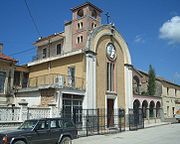
The Archdiocese of Durrës was created in the 13th century as the Bishopric of Albanopolis. It united with Tirana in 1992. The Diocese of Rrëshen was split off in 1996.
The Apostolic Administration of Southern Albania was created in 1939.
Other former ancient Diocese in Albania were Dinnastrum and Balazum.
The Cathedral of Shkodër
The service in the Cathedral of Shkodër is most impressive, although primitive to an extreme degree. There is little quiet, for the congregation rasps out the responses with a fervour that precludes either modulation or rhythm, and the incessant rattle of the coins on the women's clothing as they bend forward and again kneel upright accompanies every intonation. The scarlet colour predominates in the altar decorations as well as in the clothes of the worshipers.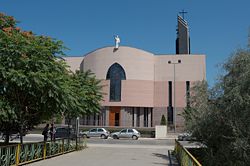
The Mirdite tribe
The Mirdite tribe, the only tribe where the Albanian language and religion is still the same as centuries before. The oldest families (which are brothers in the same time) are: Oroshi (leading family of the Mirdite), Kushneni and Spaqi. Fandi and Dibri family were hosted by the Mirdite (they came from southern Kosovo) later when those two tribe didn't want to obey the rules of the Ottoman Empire,thus, the perfect place for this was Mirdite.The Mirdites are known for their continuous fights against different invaders, especially with Ottoman Empire and Slavic Countries such as Serbians.
The Congress of Berlin and Albanian resistance
The revival of the national aspirations of Albania dates from the Congress of BerlinCongress of Berlin
The Congress of Berlin was a meeting of the European Great Powers' and the Ottoman Empire's leading statesmen in Berlin in 1878. In the wake of the Russo-Turkish War of 1877–78, the meeting's aim was to reorganize the countries of the Balkans...
(1878), when Austria, in order to compensate Serbia and Montenegro for her retention of the of Bosnia and Herzegovina
Bosnia and Herzegovina
Bosnia and Herzegovina , sometimes called Bosnia-Herzegovina or simply Bosnia, is a country in Southern Europe, on the Balkan Peninsula. Bordered by Croatia to the north, west and south, Serbia to the east, and Montenegro to the southeast, Bosnia and Herzegovina is almost landlocked, except for the...
, thought to divide the land of Albania between them. The Turks secretly fostered the opposition of both Musulmans and Catholics, and the Albanian League was formed "for the maintenance of the country's integrity and the reconstitution of its independence".
The territories allotted to Serbia were already occupied by her troops when resistance broke forth, and the idea of dislodging them had to be abandoned; but Montenegro was unable to obtain possession of her share, the rich districts of Gusinje
Gusinje
Gusinje is a small town in Montenegro. According to the 2003 census, the town has a population of 1,704.-History:The history and origins of Gusinje are unknown prior to the Ottoman conquests. Before the Ottoman Turks took control of the region, Plav-Gusinje was under the control of various...
and Plav
Plav
Plav Plav Plav (Montenegrin, (Albanian: Plav) is a town in north-eastern Montenegro. It has a population of 3,615 (2003 census).Plav is the centre of the municipality (population of 13,805),-Geography:...
. The Albanians, undaunted by the unexpected opposition of their former allies, the Turks, now forced by Russia to assist Montenegro, stood against all their enemies with a determination that baffled and dismayed Europe. Mehemet Ali was routed, his house at Đakovica burned down, and himself massacred.
The Albanians had much to avenge. They had not yet forgotten the war of a century before when their women flung themselves by hundreds over the roads near Yamina to escape Ali Pasha
Ali Pasha
Ali Pasha of Tepelena or of Yannina, surnamed Aslan, "the Lion", or the "Lion of Yannina", Ali Pashë Tepelena was an Ottoman Albanian ruler of the western part of Rumelia, the Ottoman Empire's European territory which was also called Pashalik of Yanina. His court was in Ioannina...
's soldiers. The Turks finally relinquished their efforts to quell the movement they had themselves helped to bring about, and Montenegro had to contend itself with the barren tracts of the Bojana
Bojana River
The Bojana or Buna , is a 41 km long river in Albania and Montenegro which flows into the Adriatic Sea. An outflow of Lake Skadar, measured from the source of the lake's longest tributary, the Morača, the Morača-Lake Skadar- Bojana system is 183 km long.- The river in Albania :The river...
and the port of Ulcinj
Ulcinj
Ulcinj is a coastal resort town and municipality in Montenegro. The town of Ulcinj has a population of 10,828 of which the majority are Albanians...
. She could not have aspired even to these, had not Russia, anxious to spread the doctrines of "Orthodoxy", advocated the dismemberment of Catholic and Muslim Albania in favour of the Serbian race.
Demographics
No clear statistics of any Turkish empire province has been assimilated. What is known though is that before the independence of Albania from Turkey, when the country had 1,500,000 inhabitants, the population's religious percentages were as these: 65% MuslimMuslim
A Muslim, also spelled Moslem, is an adherent of Islam, a monotheistic, Abrahamic religion based on the Quran, which Muslims consider the verbatim word of God as revealed to prophet Muhammad. "Muslim" is the Arabic term for "submitter" .Muslims believe that God is one and incomparable...
, 25% Albanian Orthodox and 10% Roman Catholic. Nonetheless, the statistics have changed significantly to this: 38,8% Muslim
Muslim
A Muslim, also spelled Moslem, is an adherent of Islam, a monotheistic, Abrahamic religion based on the Quran, which Muslims consider the verbatim word of God as revealed to prophet Muhammad. "Muslim" is the Arabic term for "submitter" .Muslims believe that God is one and incomparable...
(30% Sunni Muslim, 8% Bektashi
Bektashi
Bektashi Order or Bektashism is an Islamic Sufi order founded in the 13th century by the Persian saint Haji Bektash Veli. In addition to the spiritual teachings of Haji Bektash Veli the order was significantly influenced during its formative period by both the Hurufis as well as the...
), 16,8%-17% Roman Catholic and 16%-16,1% Albanian Orthodox. .
A Pew Research Center
Pew Research Center
The Pew Research Center is an American think tank organization based in Washington, D.C. that provides information on issues, attitudes and trends shaping the United States and the world. The Center and its projects receive funding from The Pew Charitable Trusts. In 1990, Donald S...
demographic study from 2009 put the percentage of Muslim
Muslim
A Muslim, also spelled Moslem, is an adherent of Islam, a monotheistic, Abrahamic religion based on the Quran, which Muslims consider the verbatim word of God as revealed to prophet Muhammad. "Muslim" is the Arabic term for "submitter" .Muslims believe that God is one and incomparable...
s in Albania at 79.9%.
The CIA World Factbook gives a distribution of 70% Muslims, 20% Eastern Orthodox, and 10% Roman Catholics.
Sources
- William Martin LeakeWilliam Martin LeakeWilliam Martin Leake, FRS , British antiquarian and topographer, was born in London.After completing his education at the Royal Military Academy, Woolwich, and spending four years in the West Indies as lieutenant of marine artillery, he was sent by the government to Constantinople to instruct the...
, Travels in Northern Greece (London, 1835) - Élisée ReclusÉlisée ReclusÉlisée Reclus , also known as Jacques Élisée Reclus, was a renowned French geographer, writer and anarchist. He produced his 19-volume masterwork La Nouvelle Géographie universelle, la terre et les hommes , over a period of nearly 20 years...
, The Earth and its Inhabitants (New York, 1895, Eng. tr.): Europe, I, 115-126 - Gustave Léon Niox, Péninsule des Balkans
- Edith DurhamEdith DurhamMary Edith Durham was a British traveller, artist and writer who became famous for her anthropological accounts of life in Albania in the early 20th century.-Early life:...
, Travels - John Gardner WilkinsonJohn Gardner WilkinsonSir John Gardner Wilkinson was an English traveller, writer and pioneer Egyptologist of the 19th century. He is often referred to as "the Father of British Egyptology".-Childhood and education:...
, almatia and Montenegro (1848) - Herder, Konvers. Lex., s. v.
- Ami BouéAmi BouéAmi Boué , Austrian geologist, was born at Hamburg, and received his early education there and in Geneva and Paris....
, la Turquie d'Europe (Paris, 1889) - Alexandre Degrand, Souvenirs de la Haute-Albanie (Paris, 1901)
- Emanuele Portal, Note Albanesi (Palermo, 1903)
The documents of the medieval religious history of Albania are best found in the eight volumes of Daniele Farlati
Daniele Farlati
Daniele Farlati was an ecclesiastical historian.Farlati was born in San Daniele del Friuli in the present Italian province of Udine. After having studied in Gorizia he entered, in 1707, the Society of Jesus in Bologna...
, Illyricum Sacrum (Venice, 1751–1819). See also Augustin Theiner
Augustin Theiner
Augustin Theiner was a German theologian and historian.He was the son of a shoemaker. As a boy he was a pupil at the gymnasium of St. Mathias at Breslau, and studied theology in the same city. Together with his brother Anthony he wrote, Einfuhrung der erzwungenen Ehelosigkeit bei den Geistlichen...
, Vetera Monumenta Slavorum meridionalium historiam illustrantia (Rome, 1863 sqq.). Ecclesiastical statistics may be seen in O. Werner, Orbis Terrarum Catholicus (Freiburg, 1890), 122-124, and 120; also in the Missiones Catholicæ (Rome, Propaganda Press, triennially).

